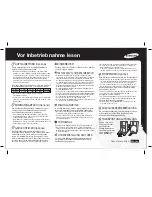
Safety instructions
This unit contains the coolant
isobutane (R 600a), a natural gas
which is very environmentally
friendly but also combustible. When
transporting and installing the unit
care must be taken to ensure that none of the
refrigeration circuit components become
damaged. In the event of damage avoid naked
flames or ignition sources and ventilate the room
in which the unit is placed for a few minutes.
How to dispose of the old unit
Before disposing of an old, scrap unit no
longer in use, it is imperative to render it safe
and inoperative at once. Disconnect power
supply plug and cut off connection lead.
Remove or destroy all spring, latch or bolt-
locks, ensuring that these have been made
totally unserviceable. This will prevent the
danger of children locking themselves in
inadvertently.
Please observe refrigeration and freezer
units contain insulating gases and coolants
which require specialised vaste disposal.
They also contain valuable materials which
can be recycled. Entrust the disposal of a scrap
unit categorically to the competence of your
local waste disposal service and contact your
local authority or your dealer if you have any
questions. Please ensure that the pipework of
your refrigerating unit does not get damaged
prior to being picked-up by the relevant waste
disposal service, and contribute to environmental
awareness by insisting on an appropriate,anti-
pollution method of disposal.
Disposing of the packaging of your new
appliance
All the packaging materials employed in the
packing of your new appliance may be disposed
of without any danger to the environment.
The cardboard box may be broken or cut into
smaller pieces and given to a waste paper
disposal service. The wrapping foil is made of
polyethylene and the polysterene pads and
stuffing contain no fluorochloric hydrocarbons.
All these valuable materials may be taken to
a waste materials collecting center and used
again after adequate rework. (Recycling).
Consult your local authorities for the name
and address of the waste materials collecting
centers of the waste paper disposal services
nearest to your home.
Figure
1
shows the most important features
of your combined appliance:
1. CONTROL PANEL for controlling all the
appliance functions.
2. REFRIGERATOR COMPARTMENT for
storing fresh food and drinks.
3. FREEZER COMPARTMENT for storing
frozen food and freezing fresh produce.
4. REFRIGERATOR DOOR with fittings for
eggs, dairy products (butter, cheese,
yoghurt, etc.) and bottles.
5. Refrigerator LIGHT FITTING.
7. Fresh FRUIT AND VEGETABLE BOXES.
8. FREEZER DOOR.
9. ICE COMPARTMENT for making and
storing ice cubes.
10. SUPER-FREEZE DRAWER for freezing
fresh food.
11. STORAGE DRAWER for frozen food.
12. Vented BASE PLATE.
13. Defrosting drain.
14. Ventilator.
These are shown on the DATA PLATE inside
the refrigerator on the left-hand side near the
Vegetable Box.
Figure
2
shows the dimensions which you
should bear in mind when deciding where to
install your appliance.
Read the following before deciding on the
final position of your appliance:
- Do not install near a SOURCE OF HEAT
(heater, cooker, radiator, etc.)
- The bottom GRILLE must be left clear to
allow a FLOW OF AIR though to the back.
- If installing the appliance in a FITTED
KITCHEN under a CUPBOARD, check that
the cupboard and the appliance stand at
least 50 mm clear of the wall to allow a
FLOW OF AIR behind (figure
3
).
24
SAFETY AND ENVIRONMENTAL ADVICE,
REGULATIONS
GENERAL DESCRIPTION
TECHNICAL DATA
DIMENSIONS
POSITION
EN.qxd 02/02/05 9:15 Page 24
Summary of Contents for Refrigerator-freezer
Page 1: ......
Page 2: ......
Page 13: ...PT qxd 02 02 05 9 14 Page 12 ...
Page 23: ...PT qxd 02 02 05 9 14 Page 22 ...









































